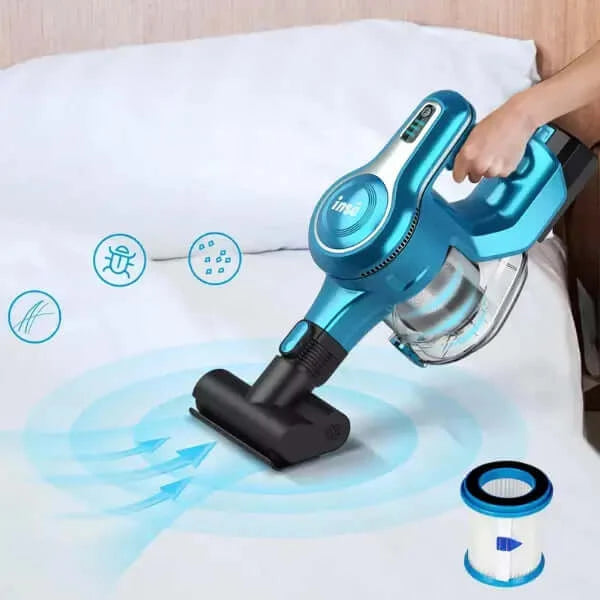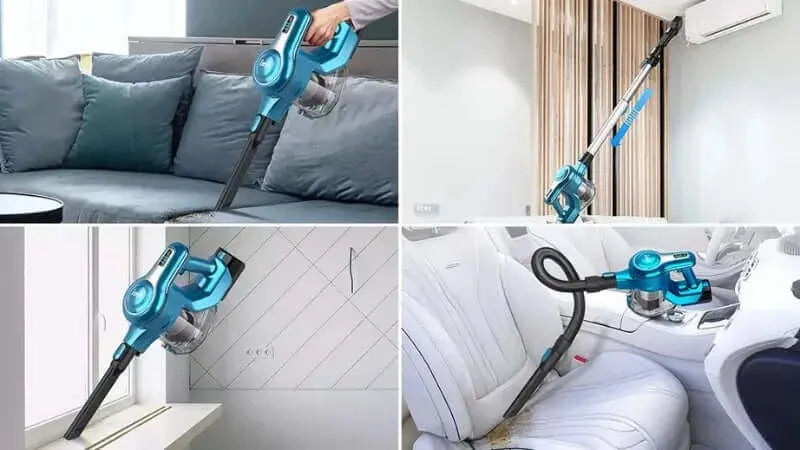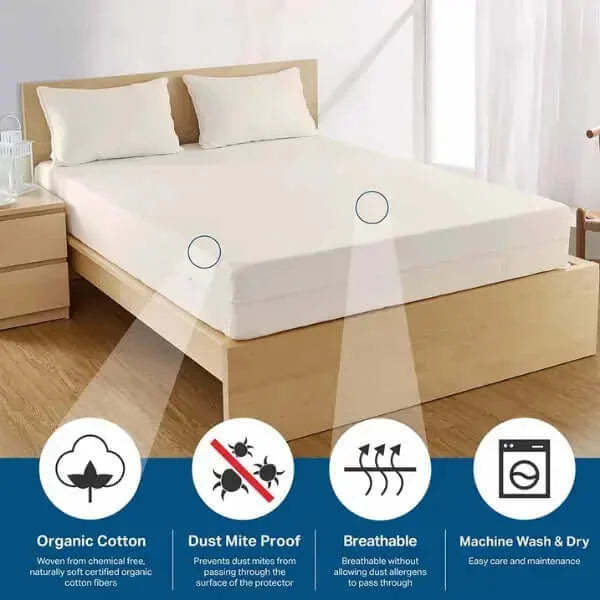Introduction
Living with allergies can be a constant struggle; itchy eyes, runny nose, and sneezing can make even the simplest tasks a challenge. As allergy sufferers, we know that keeping a clean home is essential to reduce allergens and maintain a healthy living environment. In this blog, we'll first help you get a better understanding about allergies, then we share expert cleaning tips to help you tackle allergens and create a more comfortable space for you and your family. We'll also discuss the importance of using the best vacuum for allergy help you breathe easier.
Table of Contents
➡️ 2. Identifying Common Household Allergens
➡️ 3. What are the 7 Allergy Symptoms
➡️ 4. Top Cleaning Tips for Allergy Sufferers
➡️ 5. The Role of Vacuum Cleaners in Allergy Management
➡️ 6. How to select an Allergy Vacuum
➡️ 7. Our Top Vacuum Cleaner Recommendation for Allergies
➡️ 8. Additional Resources for Allergy Management
What is an Allergy
Allergies are a hypersensitive reaction of the immune system to normally harmless substances such as pollen, pet dander, or certain foods. This reaction occurs when the immune system produces an antibody called immunoglobulin E (IgE) in response to an allergen. This triggers a series of reactions that release chemicals such as histamine into the bloodstream, resulting in symptoms such as sneezing, itching, hives, and swelling. Allergies can range from mild to severe and can affect various parts of the body, including the nose, eyes, skin, and respiratory system. Identifying and avoiding allergens is an important part of managing allergies, as is seeking medical treatment for severe or persistent symptoms.
Identifying Common Household Allergens
Allergies can be a frustrating and uncomfortable experience, especially when they're triggered by common household allergens. Identifying these allergens is the first step in managing and reducing your allergy symptoms. Here are some of the most common household allergens to be aware of:
1. Dust mites
Dust mites are tiny creatures that thrive in warm and humid environments. They feed on dead skin cells and can be found in bedding, carpets, and upholstery. Dust mites can trigger allergy symptoms such as sneezing, itching, and congestion.

2. Pet dander
Pet dander is made up of tiny flakes of skin that pets shed naturally. These flakes can trigger allergy symptoms in some people, especially those with allergies to dogs and cats.
3. Mold and mildew
Mold and mildew are types of fungi that grow in damp environments such as bathrooms, kitchens, and basements. Exposure to mold can trigger allergy symptoms such as coughing, wheezing, and nasal congestion.
4. Pollen
Pollen is a common outdoor allergen that can find its way indoors through open windows and doors. Pollen can trigger allergy symptoms such as sneezing, runny nose, and itchy eyes.
It's important to note that these common household allergens can trigger allergy symptoms year-round, not just during their respective seasons. Additionally, allergen levels can vary depending on a variety of factors, such as humidity levels and the presence of other irritants in the air.
What are the 7 Allergy Symptoms
There are several common allergy symptoms, but not all individuals with allergies will experience all of these symptoms. Here are seven of them:

1. Sneezing
Sneezing is a common symptom of allergies, triggered by the release of histamine in response to an allergen.
2. Runny or stuffy nose
Allergies can cause inflammation in the nasal passages, leading to a runny or stuffy nose.
3. Itchy, watery eyes
Allergies can cause the eyes to become itchy and watery, making it difficult to focus or concentrate.
4. Skin rash or hives
Allergies can cause skin irritation, resulting in a rash or hives.
5. Fatigue
Allergies can cause fatigue or a feeling of exhaustion due to the body's immune response to the allergen.
6. Headache
Allergies can trigger headaches, often due to sinus pressure or congestion.
7. Difficulty breathing
In severe cases, allergies can cause difficulty breathing, wheezing, or shortness of breath, which can be life-threatening and require immediate medical attention.
Top Cleaning Tips for Allergy Sufferers
1. Establish a regular cleaning routine
Establishing a regular cleaning routine is one of the most important steps in managing household allergens. This means setting aside time each week to clean your home thoroughly. The frequency and intensity of your cleaning routine will depend on the specific allergens you're dealing with and the severity of your allergy symptoms.
When establishing your cleaning routine, be sure to include all areas of the home, paying special attention to high-traffic areas and areas where allergens are likely to accumulate. This includes carpets, upholstery, bedding, and other soft surfaces that can trap allergens. By keeping up with cleaning on a regular basis, you can reduce the number of allergens that accumulate over time and keep your home cleaner and healthier.
2. Use allergy-friendly cleaning products
Many cleaning products contain harsh chemicals that can aggravate allergy symptoms. To reduce your exposure to these chemicals, look for products that are labeled as allergy-friendly or use natural cleaning solutions such as vinegar and baking soda. These products are typically gentler on the skin and respiratory system and can help reduce your exposure to allergens.
When selecting cleaning products, be sure to read the labels carefully and choose products that are safe for your specific allergy symptoms. In addition, be sure to use these products as directed to maximize their effectiveness and reduce the risk of adverse reactions.
3. Prioritize high-traffic and common allergy areas
When cleaning your home, it's important to focus on areas that see the most traffic and are most likely to harbor allergens. This includes areas such as living rooms, bedrooms, and kitchens. Pay special attention to areas where allergens are likely to accumulate, such as carpets, bedding, and upholstery.
To effectively clean these areas, use a vacuum cleaner with a HEPA filter to remove dust mites, pet dander, and other allergens from carpets and upholstery. In addition, use a damp cloth to wipe down surfaces and remove pollen and other outdoor allergens. By prioritizing high-traffic and common allergy areas, you can reduce your exposure to allergens and enjoy a cleaner, healthier home environment.

4. Control humidity levels
Dust mites and mold thrive in humid environments, so it's important to keep your home's humidity levels in check. Use a dehumidifier in damp areas such as bathrooms and basements to reduce moisture levels. This can help prevent the growth of mold and reduce the presence of dust mites.
In addition to using a dehumidifier, be sure to fix any leaks or water damage as soon as possible to prevent the growth of mold and other allergens. By controlling humidity levels in your home, you can reduce the presence of allergens and improve indoor air quality.
5. Deal with clutter
Clutter can trap allergens and make them harder to clean up. Keep your home organized and clutter-free to make cleaning more efficient and effective. This can also help reduce the number of places where allergens can accumulate.
To deal with clutter, start by identifying areas of your home that tend to accumulate clutter, such as closets, basements, and garages. Then, take steps to organize these areas and reduce the amount of clutter. Use storage bins, shelving, and other organizational tools to keep items off the floor and out of the way. By reducing clutter in your home, you can make cleaning more effective and reduce the presence of allergens.
The Role of Vacuum Cleaners in Allergy Management
Vacuum cleaners can play a critical role in managing household allergens by removing dust, dirt, and other allergens from carpets, upholstery, and other surfaces.
1. Removing allergens from carpets and upholstery
Carpets and upholstery are notorious for trapping allergens such as dust mites, pet dander, and pollen. Vacuuming these surfaces on a regular basis can help remove these allergens and reduce your exposure to them. In addition, vacuuming can help prevent the accumulation of these allergens over time, making cleaning more effective and reducing the risk of allergy symptoms.
2. Improving indoor air quality
In addition to removing allergens from surfaces, vacuum cleaners can also help improve indoor air quality. This is because vacuum cleaners with HEPA filters can trap small particles such as dust, pollen, and pet dander, preventing them from becoming airborne and impacting indoor air quality.
How to select an Allergy Vacuum
When selecting a vacuum cleaner for allergy management, there are several features to look for, including:
1. HEPA filters
HEPA filters are designed to trap small particles such as dust, pollen, and pet dander, making them an ideal choice for allergy sufferers. Look for vacuum cleaners with HEPA filters to maximize their effectiveness in removing allergens from your home. While it is possible to wash a HEPA filter, it is generally not recommended as the water can damage the filter and reduce its effectiveness in capturing particles. Instead, it is recommended to replace the HEPA filter when it becomes dirty or clogged, typically every 6-12 months depending on usage.
2. Powerful suction
Vacuum cleaners with powerful suction are more effective at removing dirt and debris from carpets and upholstery. This can help remove allergens more effectively, reducing your exposure to them over time.
3. Allergy-friendly design
Some vacuum cleaners are designed specifically for allergy sufferers, with features such as sealed systems and washable filters that can help reduce the spread of allergens. Look for vacuum cleaners with these features to make cleaning more effective and reduce your exposure to allergens.
Our Top Vacuum Cleaner Recommendation for Allergies
If you're looking for a vacuum cleaner specifically designed to manage household allergens, our top recommendation is the INSE S6P Pro cordless vacuum. Here's why:
The INSE S6P Pro with two batteries is a high-quality vacuum cleaner that is designed to remove allergens from hard floors, low-pile carpets, upholstery, and other surfaces. Some of its key features and benefits include:
HEPA filter: This HEPA vacuum is equipped with a HEPA filter that captures small particles such as dust, pollen, and pet dander, making it an ideal choice for allergy sufferers.
Powerful suction: Up to 23Kpa that is effective at removing dirt and debris from carpets and upholstery, helping to remove allergens more effectively.
Useful Accessories: Unlike other vacuum cleaners that only have a few accessories, it has up to 5 accessories, including a motorized head brush to clean the floor, a bed brush to clean the bed bugs and mites, a flexible hose to clean upholstery, a crevice tool, and a 2-in-1 cleaning brush.

Here's what some customers have to say about this allergy vacuum cleaner:
"I have severe allergies and this vacuum has been a lifesaver. It sucks up everything and the HEPA filter really makes a difference."
"I was skeptical at first, but after using this vacuum for a few weeks, I noticed a significant improvement in my allergy symptoms. Highly recommend!"
Overall, the INSE S6P Pro is an excellent choice for allergy sufferers who want a vacuum cleaner that effectively removes allergens from their homes.
Additional Resources for Allergy Management
1. Air purifiers
Air purifiers are designed to remove airborne allergens such as dust, pollen, and pet dander from the air in your home. They work by pulling air through a filter that traps these particles, improving indoor air quality and reducing your exposure to allergens.
When selecting an air purifier for allergy and asthma management, look for models with HEPA filters and adjustable fan speeds. This will ensure that the air purifier is effective at removing allergens and can be customized to your specific needs.
2. Allergy-proof bedding
Allergy-proof bedding is designed to reduce your exposure to allergens such as dust mites, pollen, and pet dander while you sleep. These products typically include pillow and mattress covers that are made from materials that are resistant to allergens and can be easily washed to remove any accumulated allergens.
When selecting allergy-proof bedding, look for products that are labeled as allergy-friendly and made from materials such as microfiber or tightly woven fabrics that can effectively block allergens.

3. Local support groups and resources
Local support groups and resources can provide valuable information and support for those with allergies and asthma. These groups can connect you with other allergy and asthma sufferers in your area, provide information on local allergens and treatments, and offer resources such as educational materials and events.
To find local support groups and resources, check with your healthcare provider, local hospital, or clinic, or search online for organizations such as the American Academy of Allergy, Asthma & Immunology, and Ant and Allergy Associate.
Conclusion
In conclusion, managing allergies and asthma is crucial for maintaining a healthy and comfortable living environment. A multi-faceted approach that includes regular cleaning, using allergy-friendly products, and utilizing additional resources such as air purifiers, allergy-proof bedding, and local support groups can significantly reduce exposure to allergens and improve the overall quality of life. By taking proactive steps to manage your symptoms, you can enjoy a cleaner, healthier home that is free from the discomfort and irritation of allergies and asthma.

